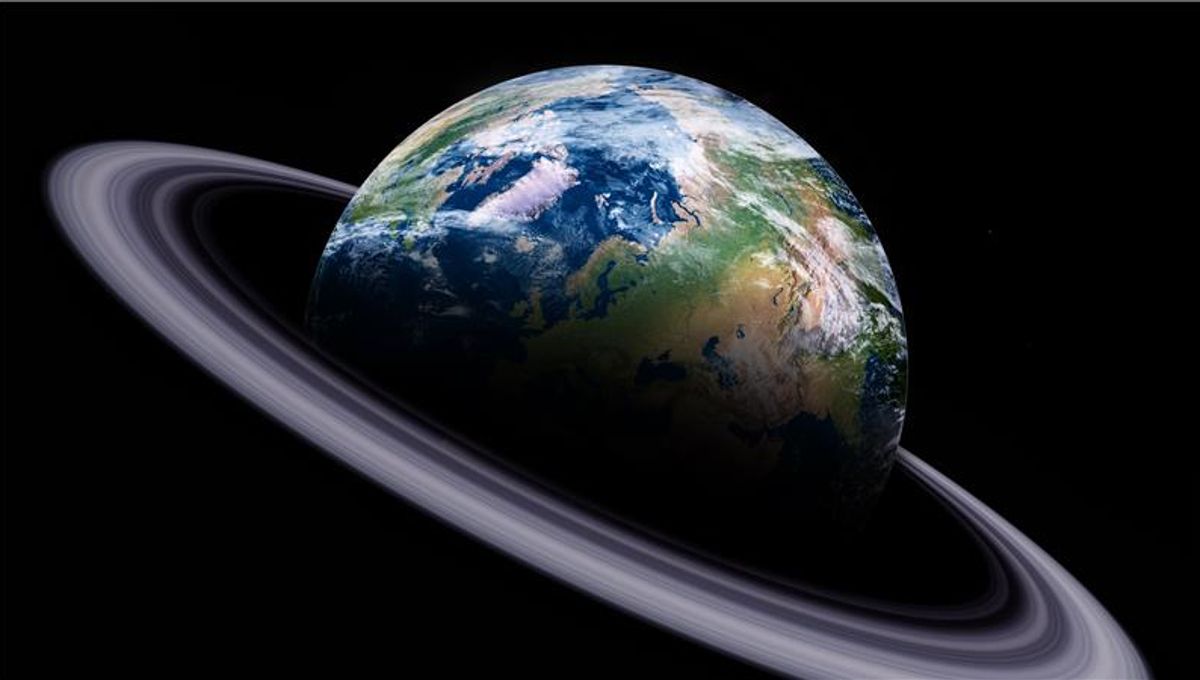
New research challenges what we know of our planet’s ancient past, suggesting that a ring formed around the Earth around 466 million years ago. Not only could this hypothesis explain an unusually high period of impacts captured in the geological record, but it may have also influenced the planet’s climate.
The Earth has a complicated history of interactions with materials from our solar system. The big one most people know of is the Chicxulub impact, which killed the dinosaurs around 66 million years ago. However, this is just one example of an impact, and a pretty late one too. Around 466 million years ago, at the beginning of the Ordovician period, many more meteorites crashed to the Earth, leaving specific impact craters in the geological record.
This has baffled scientists for some time: Plate tectonic reconstructions of this period show the positions of 21 impact craters located within 30 degrees of the equator, which is odd given that 70 percent of Earth’s continental crust lies outside this region.
Modelling impacts
When asteroids hit the Earth, they tend to do so at random locations. This is apparent when we look at impact craters on other celestial bodies, such as the Moon or Mars. However, it was not the case for the Ordovician impact craters.
When investigating the distribution of these impacts, Professor Andy Tomkins – from Monash University’s School of Earth, Atmosphere and Environment – and colleagues calculated the continental surface area capable of preserving craters from that time. They focused on a few specific factors: stable, undisturbed cratons that had rocks older than the mid Ordovician period. But they excluded areas buried under sediments or ice, eroded regions and any affected by tectonic activity.
They then used a Geographic Information System (GIS) approach, which identified geologically suitable regions across the planet. This included places like Western Australia, Africa, the North American Craton (otherwise known as Laurentia), and some parts of Europe. These were regions that were deemed most suitable for preserving these craters.
They determined that only 30 percent of the suitable land area had been near the equator at the time, and yet all the recorded impacts had occurred in this region. The chances of this happening are ridiculously small. It would be like flipping a hypothetical three-sided coin and getting tails 21 times.
The team believes this localized impact pattern may have been produced after a massive asteroid came close to the planet. Essentially, when the asteroid drew too near to Earth, it broke up and became a debris ring that circled the planet.
This occurred due to the Earth’s Roche limit – a point where the tidal force of one celestial body (the Earth in this case) is too strong for another celestial body that is only held together by its own gravity (the asteroid). In this context, the latter falls apart, leaving its pieces in orbit.
“Over millions of years, material from this ring gradually fell to Earth, creating the spike in meteorite impacts observed in the geological record,” Professor Tomkins explained in a statement.
“We also see that layers in sedimentary rocks from this period contain extraordinary amounts of meteorite debris.”
Earth’s ancient climate
While the results may help explain the strange impact craters from this period, they may also have surprising implications for another aspect of the planet’s history.
“What makes this finding even more intriguing is the potential climate implications of such a ring system,” Tomkins added.
The team speculated that the ring may have cast a shadow over the Earth, which blocked sunlight. This could have contributed to the Hirnantian Icehouse, a cooling event that occurred near the end of the Ordovician period, which is recognized as one of the coldest periods in the last 500 million years of Earth’s history.
“The idea that a ring system could have influenced global temperatures adds a new layer of complexity to our understanding of how extra-terrestrial events may have shaped Earth’s climate,” Tomkins said.
This study has implications that extend way beyond a geological curiosity. It draws attention to the broader impacts celestial events may have had on Earth’s evolutionary history while also raising questions about other possible hitherto unknown ring systems. Is it possible the Earth had other rings in the past? If so, what impact did they have on our planet’s climate and the evolution of life more generally?
The paper is published in Earth and Planetary Science Letters.
Source Link: 499 Million Years Ago, Earth Potentially Had A Ring System That Impacted Its Climate